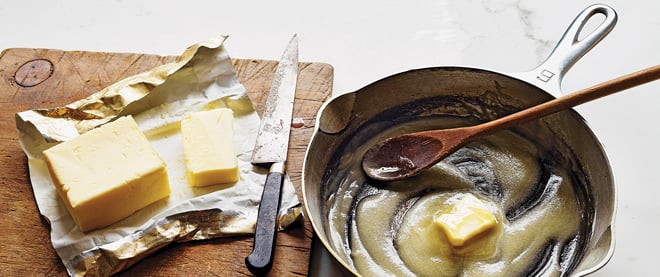The secret to cooking like a chef
If you’re thinking of skipping that final ‘stir in the butter,’ think again
Photograph by John Cullen; Getty Images, iStock; Photo illustration by Taylor Shute
Share

Butter has been on my mind of late even more than usual. Which is to say that, in addition to various long-raging but still unresolved, internal debates—like, “Exactly how much is too much to melt in my morning croissant?” and “Are there specific applications wherein the qualities of artisanal Irish butter from County Kerry actually make it superior to a French Échiré?”—I have been recently burdened with a fresh one. Specifically, I want to know how it is that so few otherwise accomplished home cooks have any idea how to properly cook with the stuff.
What got me thinking about this was my most recent cookbook collaboration with chef Mark McEwan—head judge on Top Chef Canada, owner of the top Toronto restaurants North 44, Bymark, One, and Fabbrica, as well as the fine food emporium, McEwan.
For this book—as for our last one, Great Food at Home—I spent many weeks watching his restaurants’ chefs prepare various dishes, carefully transcribing the process as it unfolded. Then I went home, recreated the dishes and pared them down to their essentials in order to write the recipes in a manner we considered best suited to the home cook.
Out with the cilantro micro-sprouts, for example, and in with the minced chives. If something cooked in three pans at one of the (dishwashing-crew-equipped) restaurants could be done very nearly as well in one pan at home, so be it. And if a two-stage cooking process could be streamlined to one with little perceptible effect, simplicity won the day. But in one area where so many other cookbooks omit a standard restaurant procedure in deference to public expectations, I made no compromise: butter.
“In a professional kitchen [butter is] almost always the first and last thing in the pan,” the inimitable Anthony Bourdain wrote, truthfully, in his classic 2001 exposé, Kitchen Confidential. “Butter is the reason my sauce tastes richer and creamier and mellower than yours, why it’s got that nice, thick opaque consistency . . . we finish nearly every sauce with it.”
I have witnessed this exquisite truism in play in more fine professional kitchens over the years than I can count. Whether the cooking is French, Italian, contemporary, or what have you, butter is everywhere. It is there at the start, and then basted over the fish, scallops, or steak in the pan. It is there in the holding bay, keeping things moist and glistening, or maybe four inches deep, as in a pan of warm beurre monté, in which a roast rests before being sliced for the plate. And it is always there at the end, being folded into pastas, risottos, and sauces of every type.
Taste a sauce before that last step and it usually seems good enough. Then taste it again, after you stir in a little tablespoon of butter, and suddenly the flavours are enriched, lifted, and bound into a beautiful new liaison. Simply put, if you are a decent cook and think something always tastes better at your local restaurant than when you make it at home, the answer is almost guaranteed to be this: butter.
And so the other day, flipping through an advance copy of Mark McEwan’s Fabbrica: Great Italian Recipes Made Easy for Home (to be published later this month), I got both hungry and reflective as, looking at favourite recipes, I noticed again that the penultimate instruction was “add the butter,” “stir in the butter,” or “fold in the butter.”
And with a sinking feeling, I kept thinking of all those home cooks who would then think to themselves, “But this tastes pretty good already. Who needs the extra calories?” And then skip directly to the next step—“. . . and serve.” Which is to say, at the precise moment when their meal might have become a great one, restaurant calibre, they stepped away and dropped the wooden spoon. All for fear of a single tablespoon of butter—100 calories—divided between about four plates, about 25 calories each.
The same as you find in, say, five McDonald’s french fries. Or the calories you could expend if, for just one week, you opened the door for yourself at the bank machine instead of pushing the handicapped button. Or one day’s worth of taking stairs instead of escalators on the subway. The choice is yours; me, I choose butter.